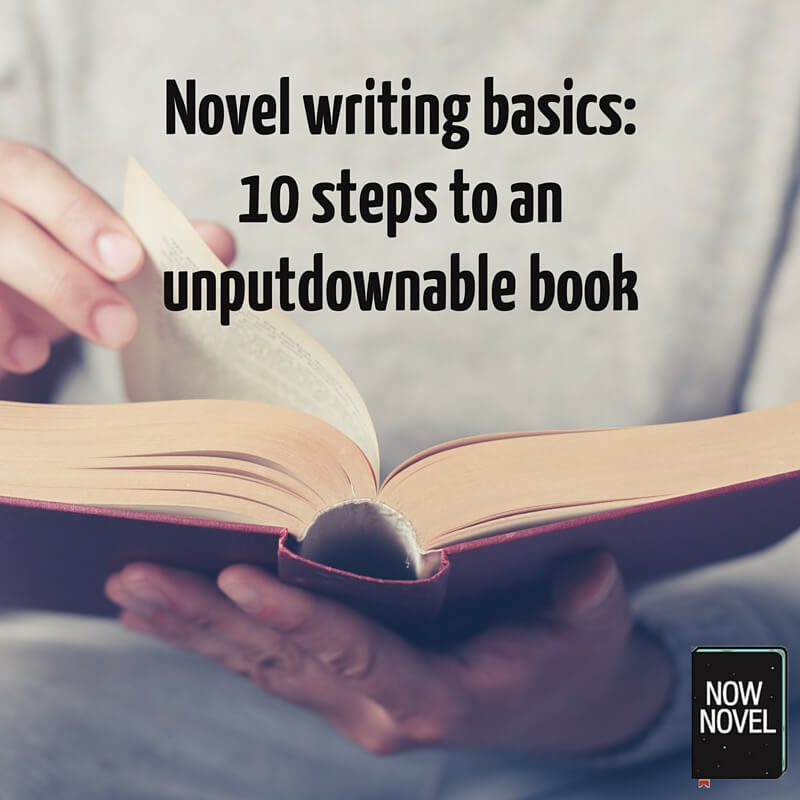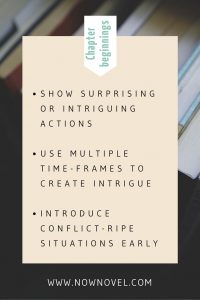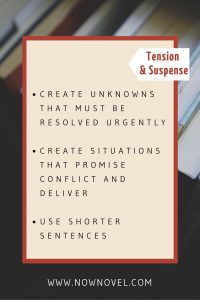Your grasp of novel writing basics such as plot and character needs to be good for readers to enjoy your novels. Here are 10 steps to make your book unputdownable:
- Promise revelation in your story premise.
- Make each chapter beginning and ending tantalizing.
- Master novel writing basics: narration and description.
- Make your characters great company.
- Mix seriousness with humor.
- Help the reader see place in your story.
- Write wish, wonder and surprise into your novel.
- Keep the story moving with suspense and tension.
- Make dialogue natural but interesting.
- Know your audience.
To expand on each of these steps and what each requires:
1: Promise revelation in your story premise
Why do people love secrets? Because we love the surprise, thrill and excitement of finding out unknowns.
One of the first novel writing basics you should master is finding an interesting story premise. Make your central novel idea promise interesting revelations from the start. Here are two examples of famous novels that do this:
- To Kill a Mockingbird by Harper Lee: Readers learn about the legal trial at the centre of the story (and a subplot involving a mysterious neighbourhood recluse) early. These two things promise readers that there will be revelations (whether the accused committed the terrible act and the origins of the recluse Boo Radley’s antisocial behaviour)
- Gone Girl by Gillian Flynn: Flynn tells her mystery story story from the opposing viewpoints of a couple in a long-term relationship. By creating inconsistencies between their versions of each other, Flynn creates the implicit promise that a truer, single version of events will emerge.
The above are two examples of how a story premise that promises revelation can hook readers.
2: Make each chapter beginning and ending tantalizing
Mastering the basics of writing novels requires learning to craft compelling beginnings and endings. To make each chapter beginning grab the reader from the start:
- Show surprising or intriguing actions: Describe a character doing something surprising, worrying, unusual or loveable. Action-based openings tell us what’s happening and set up the ‘whys’ that the story answers
- Use multiple time-frames to intrigue: If a character begins their story, ‘Since that summer, I can’t bring myself to walk down to the docks like I used to every June,’ we want to know what happened during the particular summer mentioned and how things are different in the character’s present
- Introduce conflict-ripe situations early: Don’t open with your character getting up and eating breakfast if they have a crucial job interview in the morning. Have them running late, or dress them in an outfit that will raise a few eyebrows. Create some or other detail that creates a note of suspense and uncertainty. Make the reader want to know the outcome by making it not immediately clear whether the outcome will be favourable or not
To make each section or chapter ending tantalizing:
- Make resolutions and new challenges overlap: Example: Your character gets through the job interview fine, but one of the senior partners seems unimpressed and curt. Your character can tell it’s going to be an uphill battle to win him over
- End before the reader has enough information: Instead of ending a chapter with your character finding out they got the job they needed, delay the revelation into the next chapter
Besides beginnings and endings, there are basic elements of story you must master to make your novel unputdownable:
3: Master novel writing basics: narration and description.
What is ‘narration’? Narration describes the way a story is told, including:
- Who tells the story (the narrator)
- What point of view the story’s told in (first person, second person, third person or a mixture of the three)
To master narration:
- Practice writing in different points of view (as an exercise, tell a story involving two characters and rewrite from each character’s perspective)
- Practice writing the same section of a story in multiple tenses – recent past, present continuous, future perfect (see a helpful guide to the tenses here)
To write a book that is unputdownable make narration – the way you tell a story itself – interesting. For example, in Italo Calvino’s If on a winter’s night a traveler, the book is written in second person. This means that the reader is also the main character throughout (the book opens ‘You are about to begin reading Italo Calvino’s new novel, If on a winter’s night a traveler. Relax. Concentrate.’)
Make your narration interesting by:
- Experimenting with less common styles of narration (such as using second person like Calvino)
- Creating interesting narrators (such as unreliable narrators who tell a version of the story that differs from the actual true sequence or make-up of events)
- Combining multiple points of view (as Flynn does in Gone Girl) so that contrasting versions of events create questions
Description in a novel makes it captivating and immersive. Part of why fantasy novels such as Harry Potter, A Game of Thrones and The Lord of the Rings have been major successes is that readers can picture characters’ passage through their detailed worlds.
To master description:
- Invoke all the senses (not necessarily all in the same paragraph or scene). Wherever it seems logical, appeal to the senses of sight, sound, touch, smell and taste
- Copy out any description you come across in your personal reading that you find easy to visualize and read over these often
- Visit real places that inspire your settings (or collect images in a folder to inspire specific novel settings)
- Use simile and metaphor to compare like and unlike things (F. Scott Fitzgerald describes the sky vividly in The Great Gatsby, for example, when he writes ‘The late afternoon sky bloomed in the window for a moment like the blue honey of the Mediterranean’).
4. Make your characters great company
The most addictive novel series all have characters who readers hate to part with. This doesn’t mean that characters have to be loveable. Believable, interesting villains and anti-heroes can be just as hard to say goodbye to.
To make your characters great company:
- Make them entertaining: Great characters have interesting phrases or exclamations they tend to use more than others. They have specific personalities and temperaments (such as upbeat and jovial or melancholic and thoughtful). A character is like a cracked mirror through which the reader can see the world – not reflected exactly as it is but via the character’s unique, fragmentary perspective.
- Make your characters feel real and relatable: Give each one aspirations and goals as well as shortcomings, failures and flaws
- Make your characters have internal contradictions: Someone who is constantly cracking jokes might have a secret reserve of sadness, for example. Show readers different sides to your characters because every reader will find a side of a character to love
5: Mix seriousness with humour
A novel that is all light and no shade or vice versa can start to feel relentless. Variety is part of what keeps novels interesting. Great dramatists such as Shakespeare include moments of humour in their tragedies that release tension and let the audience recover before the next grave scene.
To make your book unputdownable, find places where you can contrast serious or heartbreaking events with moments of levity. Using both modes of writing will help you to appeal to a broader base of readers because there will be something for everyone in your story.
6. Help the reader to see place in your story
Anchoring events in place is vital for mastering story writing basics. If the reader doesn’t have a clear sense of where your characters are, they can come across as talking heads floating in hazy darkness. Instead, help the reader to imagine the locations where your story takes place:
- Include place description whenever characters enter a new location to set the scene
- Remember to show how your characters and their surrounds are interwoven – two characters talking on a beach might lean closer to be heard over the sound of the sea, for example
- To make your book unputdownable, make your story locations as interesting as your characters. If you think of Mordor in Lord of the Rings with its eerie caverns and Hogwarts School in Harry Potter with its hidden passageways and talking portraits, both places are intriguing and have their own mysteries
7. Write wish, wonder, and surprise into your story
Wish, wonder and surprise are three crucial elements of an unputdownable book. Reading a novel gives you the chance to:
- See your wishes materialize in narrative (for example, the wish underlying many fantasy novels: ‘If only magic were real’)
- Experience wonder at something extraordinary or unlike anything you’ve experienced (whether a memorable comparison between two objects or a magical realm complete with mythical beasts and complicated societal rules)
- Experience surprise as events develop in ways you couldn’t possibly fortell
To make your book a page-turner, make sure that you cater to the wishes of readers of your genre. Mystery readers want to be perplexed by puzzling developments that require solving. Fantasy readers want to be taken to alternate fictional worlds that have different laws of physics and nature to our own.
Make sure there are some surprising elements in your story. Characters don’t have to disappear and reappear each chapter. But uncertainty and suspense leading to unexpected revelation create eventfulness that makes the best stories exhilarating to read.
8. Keep the story moving with suspense and tension
Suspense and tension are two story writing elements that separate an ordinary chronological retelling of events from a story. A story that hooks readers needs rising and falling action and needs to create increasing and decreasing questions in the reader. To make your book unputdownable:
- Create urgent, suspenseful unknowns (For example: ‘Why was the school’s star athlete murdered?’ Or ‘Will the main characters’ relationship survive?’)
- Create situations that promise conflict and deliver it (For example: Rival athletes are preparing for tryouts. One is honest and will try to win fairly. The other will try any tactic possible to come out on top.)
- Use shorter sentences at pivotal action points to increase tension (For example: ‘Footsteps pounding up the stairwell. Getting closer. Can only see a gloved hand gliding along the railings. I mustn’t look down. Focus!’)
To create gripping tension in your novel, read this post on ways to increase suspense.
9: Make dialogue natural yet interesting
Your characters’ conversations should be natural. Natural dialogue reads as an actual conversation, rather than a fiction-writing device. If you write an info dump, for example, that isn’t natural. Nobody says to an accomplice, ‘As you already know, we’d left the hideout yesterday when we spotted police and had to scurry back.’ In other words, your characters shouldn’t tell each other things for the reader’s specific benefit. Their conversation should be useful and necessary to them, as though it wouldn’t matter if the reader ‘overheard’ them or not.
Instead of writing info dumps or dialogue that reads like mundane, everyday speech, write great dialogue by:
- Cutting out filler words (words like ‘um’ and ‘in order to’)
- Showing characters’ personalities through the kind of language they use as well as how much or little they speak
- Writing dialogue that makes the reader feel like they’re eavesdropping. Characters should sometimes say things to each other that they wouldn’t dream of saying in front of other people.
10: Know your audience
Besides mastering novel writing basics such as writing good description and narration, make sure you know your audience whenever you start writing a novel. When you invent story ideas, ask:
- Who would the typical reader of this story be?
- What similar well-known books would they love?
Writing the book you’ve always wanted to read and writing to a specific imaginary reader whose tastes and interests you can anticipate will help you to craft an unputdownable book that ticks all of the ideal reader’s boxes.
Start the novel writing process now and use feedback from the Now Novel community to improve every aspect of your story.




11 replies on “Novel writing basics: 10 steps to an unputdownable book”
Thanks a lot for your post , it’s very helpful ! I am trying to develop my writing skills as much as possible, but still when it comes to college essays I just buy it ( via writingdone.com mostly ). My English is not perfect so that I have many things to learn.
Would this information apply to the non-fiction also?
Hi R.L. – many points would definitely apply (like a fiction novel, a good non-fiction book should be well-structured, for example). Thanks for reading.
This was very helpful, thank you! 🙂
It’s a pleasure, glad to hear that, Paige. Thanks for reading.
great……. i mean that was………. great
Thank you, Elvin. Good luck with your writing.
Great! I think I’ll write this stuff down in my notebook, and keep the notebook handy while making stories.
Glad to hear you found this useful. Enjoy. Note-keeping is useful – It’s also good practice writing out great sentences you come across in a notebook so that you build a library of inspiration that resonates with you.
thank you. I am almost ready but i feel something is missing. I can really use some of your good inspiration
Hi Ibolya, it’s our pleasure – thank you for reading the blog. I would say go for it, you can always work on the missing element of your story in a rewriting and revising process once your first draft is complete.